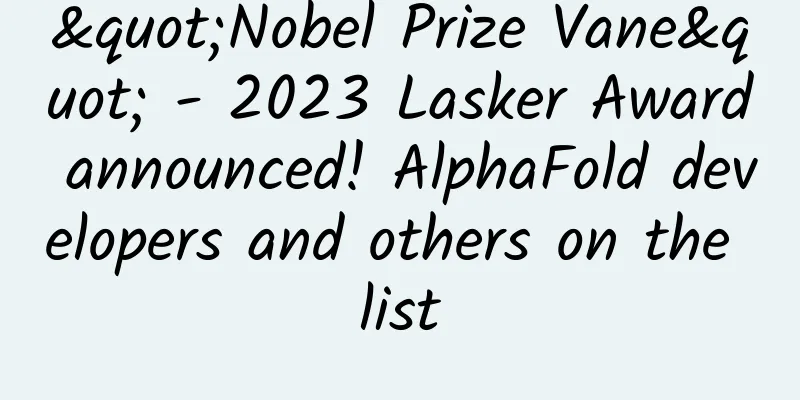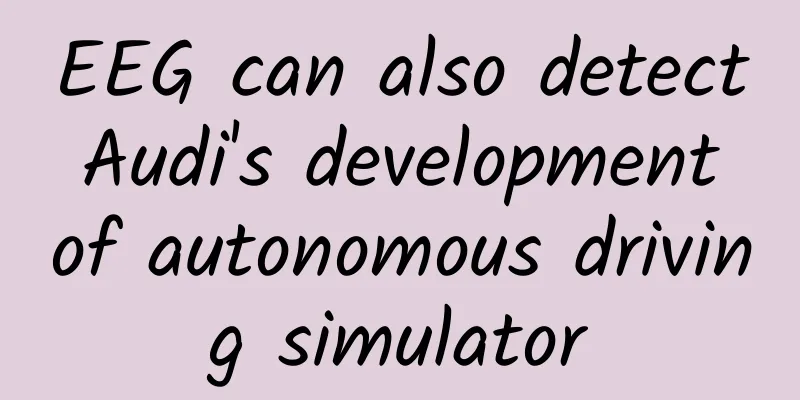"Nobel Prize Vane" - 2023 Lasker Award announced! AlphaFold developers and others on the list

|
Known as the "Nobel Prize weathervane", the highly anticipated 2023 Lasker Awards were officially announced on September 21st local time. The 2023 Lasker Basic Medical Research Award was awarded to Dr. Demis Hassabis and Dr. John Jumper of Google DeepMind in recognition of their invention of AlphaFold, a revolutionary technology that can predict the three-dimensional structure of proteins . The Clinical Medical Research Award was given to Professor James G. Fujimoto and Mr. Eric A. Swanson of MIT and Professor David Huang of Casey Eye Institute, Oregon Health & Science University in recognition of their joint invention of optical coherence tomography (OCT) technology . The recipient of the Special Achievement Award in Medical Science is Dr. Piet Borst of the Netherlands Cancer Institute, in recognition of his outstanding achievements in scientific discovery, mentorship and leadership over 50 years. Image source: The Lasker Foundation Basic Medical Research Award Image source: The Lasker Foundation The Basic Medical Research Award recognizes the two "Fathers of AlphaFold". AlphaFold is an artificial intelligence (AI) system that solves the long-standing problem of predicting the three-dimensional structure of a protein from its amino acid sequence. With outstanding creativity, unremitting efforts and superb engineering skills, Dr. Demis Hassabis and Dr. John Jumper (both from Google DeepMind) led the AlphaFold team to improve the accuracy and speed of structure prediction to unprecedented levels. This transformative approach is rapidly advancing people's understanding of basic biological processes and promoting the development of drug design. Image source: The Lasker Foundation The Basic Medical Research Award recognizes the two "Fathers of AlphaFold". AlphaFold is an artificial intelligence (AI) system that solves the long-standing problem of predicting the three-dimensional structure of a protein from its amino acid sequence. With outstanding creativity, unremitting efforts and superb engineering skills, Dr. Demis Hassabis and Dr. John Jumper (both from Google DeepMind) led the AlphaFold team to improve the accuracy and speed of structure prediction to unprecedented levels. This transformative approach is rapidly advancing people's understanding of basic biological processes and promoting the development of drug design. The mystery of protein structure Proteins in the human body play very important roles in cells, and their various physiological functions are closely related to their morphology after folding from linear amino acid chains into three-dimensional structures. In-depth insights into protein structure can clarify their functions and solve biological mysteries. More than 60 years ago, scientists have shown that the amino acid sequence of a protein encodes its final organizational structure. In theory, scientists can find out the principles that guide the amino acid chain to the correct conformation. However, for an amino acid chain, it may produce many potential conformations - even for a medium-sized protein, the time required to try all the conformational arrangements is amazing. Applying AI to protein folding There are many strategies used to try to solve protein structures. One early method developed by Professor David Baker of the University of Washington uses short fragments from a shared global database called the Protein Data Bank (PDB) to predict the local structure of proteins. Although this strategy helps in some cases, this fragment-based strategy is time-consuming and has limited applicability to the vast majority of proteins. Fast forward to 2018 and the 13th Contest for Protein Structure Prediction (CASP), where scientists have used machine learning for protein structure prediction. Unlike traditional AI methods that rely on preconceived logic, machine learning systems discover patterns from data on their own. By using machine learning as a core component of their protein structure prediction network, Dr. Hassabis and Dr. John Jumper's team won the 13th CASP competition, far ahead of the runner-up and nearly 50% higher than the best result from the 12th CASP competition. Despite their success, DeepMind researchers were not satisfied: they wanted a tool that was more useful to experimentalists, with an error of less than 1 angstrom (the size of an atom). After many rounds of debugging and brainstorming, the DeepMind research team successfully built AlphaFold2 based on the original algorithm. At CASP 2020, DeepMind's AlphaFold2 system performed amazingly. Among the nearly 100 protein targets tested, the predicted structures given by AlphaFold2 for two-thirds of the protein targets were almost the same as the structures obtained by experimental means. In some cases, it is impossible to distinguish whether the difference between the two is due to errors in AlphaFold2's predictions or illusions caused by experimental means. Dr. Hassabis and Dr. Jumper worked with the European Bioinformatics Institute at the European Molecular Biology Laboratory to share the project and database with the scientific community, and more than one million researchers have used these resources. The DeepMind team has since expanded its database catalog to nearly every known protein in organisms whose genomes have been sequenced, including the proteomes of viruses that pose epidemic threats and pathogens that are high priority for the World Health Organization. This technology has already had a huge impact in countless biomedical fields and other fields. For example, it has helped researchers fill the gap in the visualization of the nuclear pore complex, a huge and complex molecular machine that controls the transport of substances in and out of the cell nucleus. By applying AlphaFold, researchers have redesigned proteins to target human cells, opening up a new avenue for drug delivery and gene therapy. Laboratories and biopharmaceutical companies around the world are using AlphaFold to develop vaccines, design drugs, create enzymes that degrade pollutants, and more. Its application prospects are endless. The official citation for the Lasker Award reads: "By unleashing their imagination and talent, Hassabis, Jumper and their team accomplished a task that had baffled scientists for half a century. This triumph has ushered in a new era of studying and manipulating proteins. It has already catalyzed substantial progress, and its influence and scope are expected to explode as workers in many fields find ways to tap its potential." Clinical Medical Research Award Image source: The Lasker Foundation The 2023 Lasker Clinical Medical Research Award was given to the three scientists who invented OCT technology. Professor James G. Fujimoto, Mr. Eric A. Swanson, and Professor David Huang developed OCT technology in the 1990s by combining optics, telecommunications engineering, and medicine. The technology uses light beams to observe microscopic structures in human tissues such as the retina, and can produce high-resolution cross-sectional images of the internal structure of the eye in real time and painlessly without physical contact. The three scientists then founded a company to promote the popularization of the technology. In 1996, the first commercial OCT device for ophthalmic diagnosis entered the clinic. With the widespread use of this technology, doctors can quickly detect and treat diseases on the retina that can damage vision, thus saving the eyesight of millions of people and bringing revolutionary changes to the diagnosis and treatment of ophthalmology. OCT examinations are now part of standard ophthalmology care, and the medical uses of OCT are expanding. Experts and laboratory researchers around the world are exploring its potential in many medical fields, including cardiology, surgical guidance, gastroenterology, and dermatology. Engineers have integrated OCT into probes that can enter the circulatory system, and cardiologists are using these tools to examine arteries. In addition, OCT's in vivo observation capabilities also make it possible to perform optical biopsies without removing tissue for tissue biopsy. In the future, the scope and influence of OCT technology will continue to grow. Special Achievement Award in Medical Sciences Image source: The Lasker Foundation Dr. Piet Borst has made groundbreaking discoveries in many areas, with his bold attempts at new frontiers. His research has revealed how parasites evade the human immune system and has provided insights into the molecular pumps that contribute to drug resistance in cancer. He has uncovered an unexpected metabolic pathway, discovered a new building block for DNA, and pinpointed the biochemical basis of an inherited disease. With his vision and tenacity, he has taken the Netherlands Cancer Institute to world-class status. His contributions extend far beyond his home country, as he has led prestigious scientific organizations and award committees in Europe and beyond. Not only that, he has trained dozens of researchers of international renown and has applied his passion for science and rigorous approach to educating the public. |
>>: 8D Stereoscopic City! It Creates the Magic Traffic in Chongqing→
Recommend
Scientific and technological talents talk about strengthening the country | Rong Xuzheng, deputy chief designer of "Lijian No. 1": A thorough control of the avionics system of "Lijian No. 1"
Rong Xuzheng still remembers that the day he lear...
Can you lose weight by eating hamburgers, fries and cola all day? It's true! You just need to...
Recently, there was a news report abroad that a m...
Analysis of commonly used user acquisition strategies for online and offline platforms
This article mainly discusses the analysis of use...
Summary of AndroidStudio shortcut keys
Ctrl+G / Ctrl+Alt+Shift+G: Query where a variable...
Why is the Xbox One sales volume less than 40 units during the bleak "Double Eleven"?
Since Singles’ Day became a shopping festival, Do...
What are the Rockets' food, clothing, housing and transportation like? Let's talk about the Rockets' journey
This year, the Long March series of rockets will ...
The United States reported more than 48,000 new confirmed cases in a single day, and the number of confirmed cases worldwide has exceeded 10 million! Attached is the latest epidemic situation
The effective control of the domestic epidemic is...
How to review an event you have organized? From what perspectives should information and data be collected?
Xiao Wang organized an activity, hoping to increa...
First appearance! The kneeling figure and bronze beast of Sanxingdui are combined
On January 1, the Sichuan Provincial Institute of...
Chow Yun-fat's complete film collection, Chow Yun-fat's complete film collection in Mandarin version free Mandarin version Baidu Cloud
All Chow Yun-fat's movies: Chow Yun Fat was b...
10 steps to build a brand from scratch (Part 1)
Recently, new consumer product companies that hav...
Why are buildings made into "potato chips"? Not to tempt you, but because they are strong...
01 Potato Chips. What shape are you? In fact, the...
How does the training camp achieve an overall conversion rate of 81%?
I believe you must have seen various training cam...
"Cure" or "cause cancer"? The health truth behind the aspartame controversy
According to Reuters, the artificial sweetener as...
A very long guide to the user incentive system!
The user incentive system can be said to be a par...









